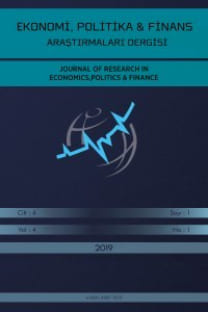İktisat Tarihinde Yöntem Kayması: Yeni İktisat Tarihi Akımına Eleştirel Bir Bakış
İktisat Tarihi, Yeni İktisat Tarihi, Kliometri
Method Shift in Economic History: A Critical Approach to the New Economic History Movement
Economic History, New Economic History, Cliometric,
___
- Aktan, C.C. ve Yay, S. (2018). Nobel ekonomi ödülü sahibi Douglass C. North’un iktisat bilimine katkıları: Yeni iktisat tarihi ve kurumsal iktisat. Hukuk ve İktisat Araştırmaları Dergisi, 10(2), 62-82. Erişim adresi: https://dergipark.org.tr/en/pub/hiad
- Brownlow, G. (2012). How do we ensure a useful future for Irish Cliometrics? Irish Economic and Social History, 39, 94-102. doi:10.7227/IESH.39.1.6
- Buğra, A. (2001). İktisatçılar ve insanlar: Bir yöntem çalışması (3. bs.). İstanbul: İletişim Yayınları.
- Conrad, A.H. and Meyer, J.R. (1958). The economics of slavery in the Ante Bellum South. Journal of Political Economy, 66(2), 95-130. https://doi.org/10.1086/258020
- Cunningham, W. (1907). The growth of English industry and commerce in modern times: The mercantile system. Cambridge: Cambridge University Press.
- Çakır, C. (2003). Türkiye’de iktisat tarihi çalışmalarının tarihi üzerine bir deneme. Türkiye Araştırmaları Literatür Dergisi, 1(1), 7-63. Erişim adresi: https://dergipark.org.tr/en/pub/talid
- Davis, L.E., Hughes, J.R.T. and Reiter, S. (1960). Aspects of quantitive research in economic history. The Journal of Economic History, 20(4), 539-547. Retrieved from https://www.jstor.org/
- Diebolt, C. (2012). Where are we now Cliometrics? Historical Social Research, 37(4), 309-326. Retrieved from https://www.jstor.org/
- Diebolt, C. and Haupert, M. (2021). Cliometrics: Past, present, and future (HAL Working Paper No. 03345558). Retrieved from https://hal.archives-ouvertes.fr/hal-03345558/document
- Fogel, R.W. (1966). The New Economic History-1: Its findings and methods. The Economic History Review, 19(3), 642-656. https://doi.org/10.2307/2593168
- Goldin, C. (1995). Cliometrics and the Nobel. The Journal of Economic Perspectives, 9(2), 191-208. doi:10.1257/jep.9.2.191
- Güran, T. (2019). İktisat tarihi. Eskişehir: Anadolu Üniversitesi Yayınları.
- Haupert, M. (2017). The impact of Cliometrics on economics and history. Revue D’économie Politique, 127(6), 1059-1082. doi:10.3917/redp.276.1059
- Kurmuş, O. (2009). Bir bilim olarak iktisat tarihinin doğuşu. İstanbul: Yordam Kitap.
- Kuznets, S. (1941). Statistics and economic history. The Journal of Economic History, 1(1), 26-41. Retrieved from https://www.jstor.org/
- Küçükkalay, A.M. (2014). Dünya iktisat tarihi. İstanbul: Beta Yayınları.
- Mainers, R.E. and Nardinelli, C. (1986). What was happened to the New Economic History? Journal of Institutional and Theoretical Economics, 142(3), 510-527. Retrieved from https://www.jstor.org/
- McCready, H. and Ashley, W. (1955). Sir William Ashley: Some unpublished letters. The Journal of Economic History, 15(1), 34-43. https://doi.org/10.1017/S0022050700066122
- Meyer, R.J. and Conrad, A.H. (1957). Economic theory, statistical inference, and economic history. The Journal of Economic History, 17(4), 524-544. Retrieved from https://www.jstor.org/
- National Bureau of Economic Research. (1958). Investing in economic knowledge. Retrieved from https://www.nber.org/system/files/chapters/c4144/c4144.pdf
- Nef, J.U. (1944). What is economic history. The Journal of Economic History, 4, 1-19. Retrieved from https://www.jstor.org/
- North, D. (1997). Cliometrics-40 years later. The American Economic Review, 87(2), 412-414. Retrieved from https://www.jstor.org/
- Rojas, A.M. (2007). Cliometrics: A market account of a scientific community (1957-2006). Lecturas de Economía, 66, 47-82. Retrieved from http://www.scielo.org.co/
- Salerno, J.T. (2002). Introduction. In M. N. Rothbard (Eds.), A history of Money and banking in the Unites States: The colonial erat o World War II (pp. 7-44). Alabama: Ludwig von Mises Institute.
- Schumpeter, J.A. (1947). The creative response in economic history. The Journal of Economic History, 7(2), 149-159. Retrieved from https://www.jstor.org/
- Shryock, R.H. (1944). What is economic history: Comment. The Journal of Economic History, 4, 20-24. Retrieved from https://www.jstor.org/
- Tekeoğlu, M. (1993). İktisadi düşünceler tarihi. Adana: Çukurova Üniversitesi Basımevi.
- The Cliometric Society. (2022a). 2021 conferences. Retrieved from https://www.cliometrics.org/conferences/
- The Cliometric Society. (2022b). World cliometric conferences. Retrieved from https://www.cliometrics.org/conferences/world-cliometrics-conferences/
- The Nobel Prize. (2022a). Robert W. Fogel: Biographical. Retrieved from https://www.nobelprize.org/prizes/economic-sciences/1993/fogel/biographical/
- The Nobel Prize. (2022b). The Sveriges Riksbank prize in economic sciences in memory of Alfred Nobel 1993. Retrieved from https://www.nobelprize.org/prizes/economic-sciences/1993/summary/
- Uzun, A. (2001). Yeni iktisat tarihi akımı ve iktisat tarihi yazımına katkıları. Cumhuriyet Üniversitesi İİBF Dergisi, 2(1), 80-93. Erişim adresi: http://eskidergi.cumhuriyet.edu.tr/
- Ward, B. (1972). What’s wrong with economics? New York: The Macmillan Press Ltd.
- Woodman, H.D. (1972). Economic history and economic theory: The New Economic History in America. The Journal of Interdisciplinary History, 3(2), 323-350. https://doi.org/10.2307/202334
- Yalçın, A. (1976). İktisadî doktrinler ve sistemler tarihi. Ankara: Ekonomik ve Sosyal Yayınlar.
- Yayın Aralığı: Yılda 4 Sayı
- Başlangıç: 2016
- Yayıncı: Ersan ERSOY
Kayıt Dışı Ekonomi Finansal Sektörün Gelişimini Kısıtlıyor mu?
Dow Jones Sukuk Endeksiyle Seçilmiş İslami Hisse Senedi Endeksleri Arasındaki Volatilite Etkileşimi
Müge SAĞLAM BEZGİN, Emine KARAÇAYIR
Türkiye’nin Gürcistan İle Dış Ticaretinde Rekabet Gücü: Balassa Akü Endeksi Analizi
Kurumsal Yönetim, Muhafazakâr Muhasebe ve Şirket Büyüklüğünün Kazanç Kalitesi Üzerine Etkisi
Kader TÜRKOĞLU, Cennet GÜRBÜZ, İsmail BEKCİ
Birleşme ve Satın Alma Haberlerinin Borsa Getirisi Üzerine Etkisi: 2005-2017 Borsa İstanbul Örneği
Yüksek Hava Kirliliği Yaşanan Ülkelerde Doğumda Yaşam Beklentisi ve Çevresel Bozulma Bağlantısı
İktisat Tarihinde Yöntem Kayması: Yeni İktisat Tarihi Akımına Eleştirel Bir Bakış
TVP-VAR Tabanlı CARR Oynaklık Bağlantılılığı: Rusya-Ukrayna Çatışmasından Kanıtlar
